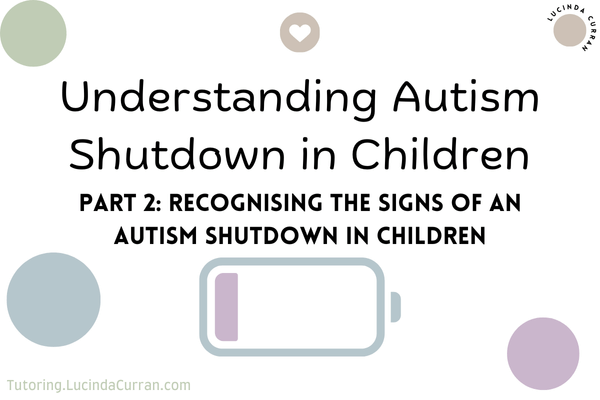Recognising the Signs of an Autism Shutdown in Children
Identifying an autism shutdown in children early on can make a big difference in how you respond.
These moments are often difficult to detect, especially if the child is unable to articulate what they’re experiencing.
Understanding the signs and being aware of any changes in behaviour will help you support your child through these challenging moments.
Key Signs of an Autism Shutdown in Children
While every child experiences autism shutdowns differently, there are a few common signs that can help you recognise when your child might be heading into a shutdown:
- Withdrawal or Disconnection: Your child may stop engaging with you or their surroundings. They may stop talking, avoid eye contact, and withdraw from physical interactions.
- Reduced Movement or Activity: Unlike meltdowns where children may exhibit frantic movements, a shutdown may involve your child becoming still or unresponsive. They may freeze in place or slump down as though they’ve “shut off” from the environment.
- Blank Facial Expression: A key sign is the lack of expression on your child’s face. Their eyes might seem glazed over, and their posture may appear stiff, as if they are in a dazed or detached state.
- Difficulty Communicating: When a child is in the middle of a shutdown, they may struggle to communicate their needs or feelings. This can be particularly difficult if your child is verbal but unable to speak during a shutdown.
- Seeking Quiet Spaces: Sometimes, children experiencing an autism shutdown will seek out a calm, quiet area to retreat. They might go to their room, hide under a blanket, or sit in a secluded space to escape the sensory overload.
What Causes an Autism Shutdown in Children?
There are several potential triggers for an autism shutdown, all of which involve overwhelming stimuli or emotions that your child’s brain is unable to process effectively. Some of the most common causes include:
- Sensory Overload: Children with autism may have heightened sensitivity to sensory stimuli like bright lights, loud noises, or strong smells. When their senses become overloaded, it can trigger a shutdown to protect their nervous system from further distress.
- Emotional Overload: Emotions like anxiety, fear, and frustration can overwhelm your child, especially if they’re struggling to regulate their feelings. A shutdown can occur when they become emotionally flooded and are unable to process or manage the overwhelming feelings.
- Changes in Routine: Autism thrives on routine and predictability, and changes—like new environments, changes in school schedules, or even unexpected events—can throw your child into a state of stress. When they can’t process these changes, a shutdown may occur.
- Physical Exhaustion: Sometimes, a child may experience a shutdown after long periods of activity, stress, or physical exertion. If your child has had a busy or particularly challenging day, their body and mind may become overwhelmed, leading to a shutdown.
How to Support Your Child During an Autism Shutdown
When your child is in the midst of an autism shutdown, they may not have the capacity to ask for help. It’s important to be there for them, providing the space and comfort they need to navigate the shutdown.
Here are some ways to support your child:
- Stay Calm: Your child’s emotional state is likely heightened during a shutdown, so it’s crucial that you remain calm and patient. Try not to pressure them to ‘snap out of it’ or engage before they are ready.
- Offer a Safe, Quiet Space: Remove your child from the overwhelming environment and guide them to a quiet space. Having a designated area for them to retreat to can help them calm down in a safe, controlled space.
- Provide Comforting Objects: If your child has sensory preferences like weighted blankets or calming toys, offer these to help ground them during a shutdown.
- Avoid Overwhelming Them with Questions: If your child is not responding to you, avoid bombarding them with questions or demands. Instead, offer comforting words or simply sit with them to provide reassurance.
Understanding and Supporting Your Child
Autism shutdowns in children are challenging to navigate, but with patience, understanding, and proactive support, you can help your child through these moments.
By recognising the signs and identifying triggers, you’ll be better equipped to prevent shutdowns or support your child when they occur.
Remember, each child is different, and finding what works best for your child may take time and experimentation.
Supporting your child through an autism shutdown is about creating a space where they can feel safe to retreat, process, and eventually regain control.
With the right tools and mindset, you can empower your child to manage these moments and build the resilience they need.






